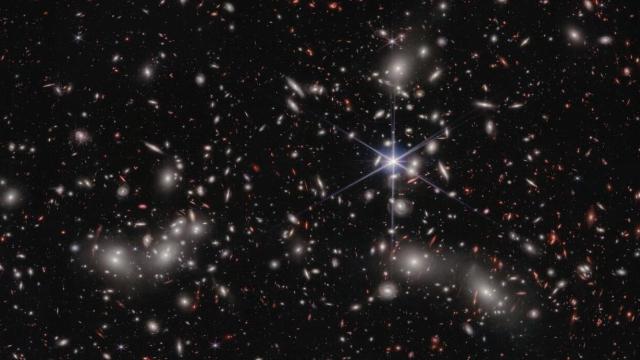A new Webb Space Telescope deep field image shows the luminous realm of Pandora’s Cluster (Abell 2744), a pileup of galaxy clusters that formed over the course of 350 million years.
The cluster has previously been imaged by a number of telescopes, including NASA’s Hubble Space Telescope and the Chandra X-ray Observatory. But now the $US10 ($14) billion Webb telescope has trained its gaze on the distant cluster, displaying about 50,000 light sources in and around the object.
The image shown above is actually four Webb images stitched together for your viewing pleasure, a European Space Agency press release explains. The images make use of a quirk of spacetime called gravitational lensing to see particularly distant, faint light sources. Gravitational lensing occurs when more distant light bends around supermassive objects on its way to Earth, due to the strong gravitational fields of those intervening objects.
When the light bends, it is refocused — essentially magnified — making it easier for telescopes like Webb to see objects that would otherwise be obscured or too faint.
Gravitationally lensed objects often appear warped; they show up in characteristic arcs. Last year, astronomers spotted the oldest star yet, a nearly 13-billion-year-old ball of gas, in a thin arc of gravitationally lensed light.
The recent imaging of Pandora’s Cluster was done as part of the Ultradeep NIRSpec and NIRCam ObserVations before the Epoch of Reionization (UNCOVER) program. This impressively acronymed work is interesting: the team is attempting to image some of the first galaxies we can see, as well as the galaxies responsible for the universe’s Epoch of Reionization.
Gravitational lensing makes such inquiry possible, and a welcome byproduct of the team’s efforts are sweeping views of the cosmos for the public to appreciate.
The mosaic of Pandora’s Cluster took about 30 hours of observations to complete. In the bottom right of the image, hundreds of never-before-seen lensed galaxies are visible as streaks or arcs. (Though the cluster has been imaged many times before, the wavelengths Webb collects means the observatory can see farther, fainter objects than other observatories.)
The team’s work isn’t done. With the NIRCam image data acquired, the researchers will conduct follow-up observations using the Webb’s NIRSpec instrument to determine the distances of the objects in this image, as well as some information about the galaxies’ makeup. According to the European Space Agency release, those observations will occur this summer.
More: Webb Telescope Captures Countless Galaxies in New Image
